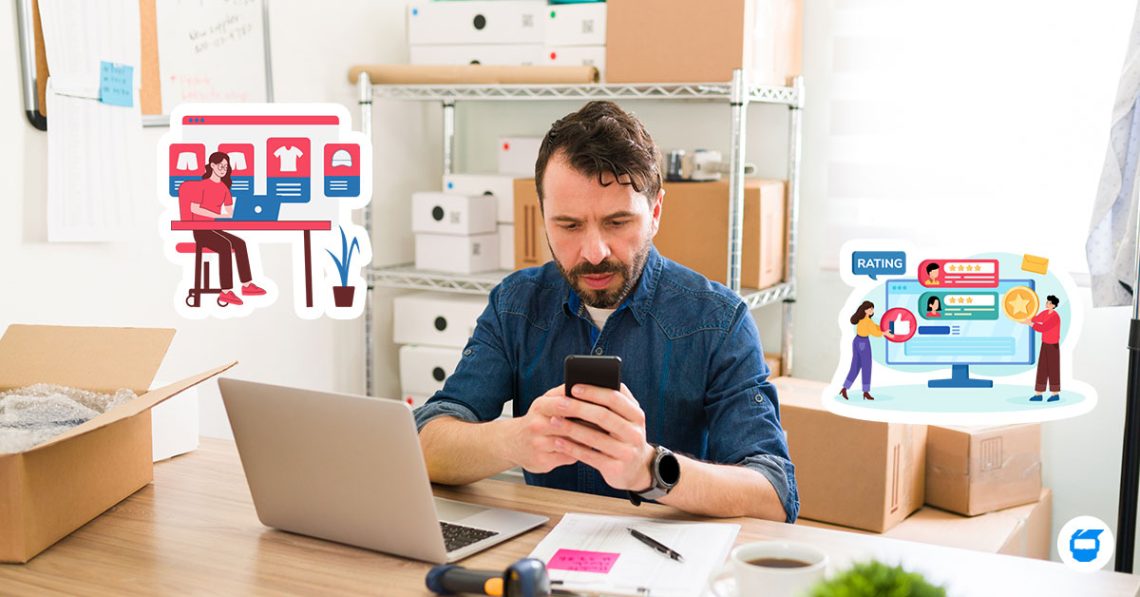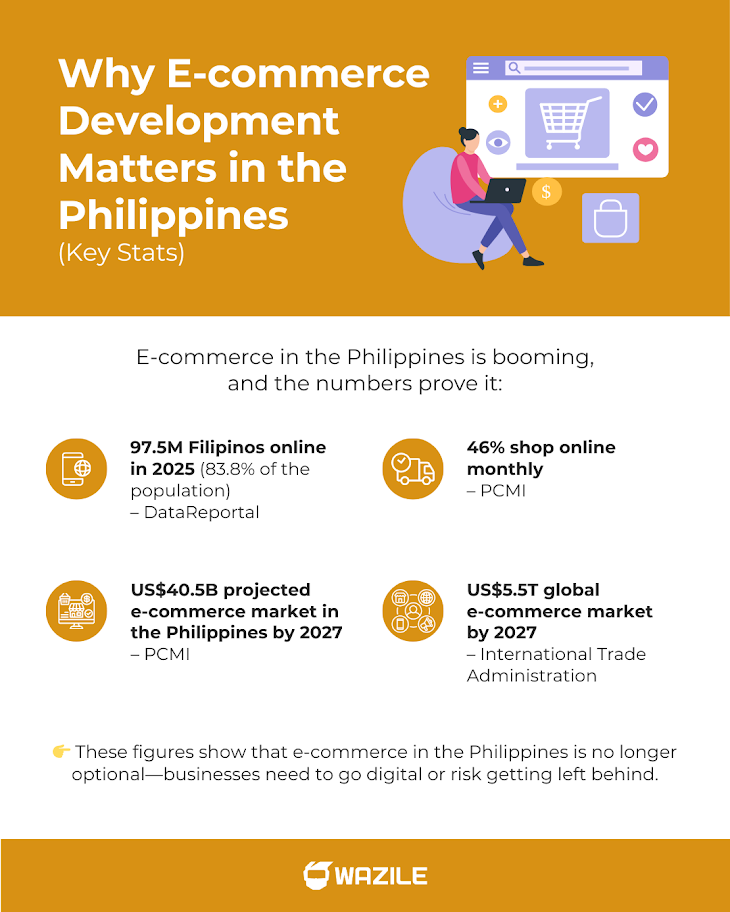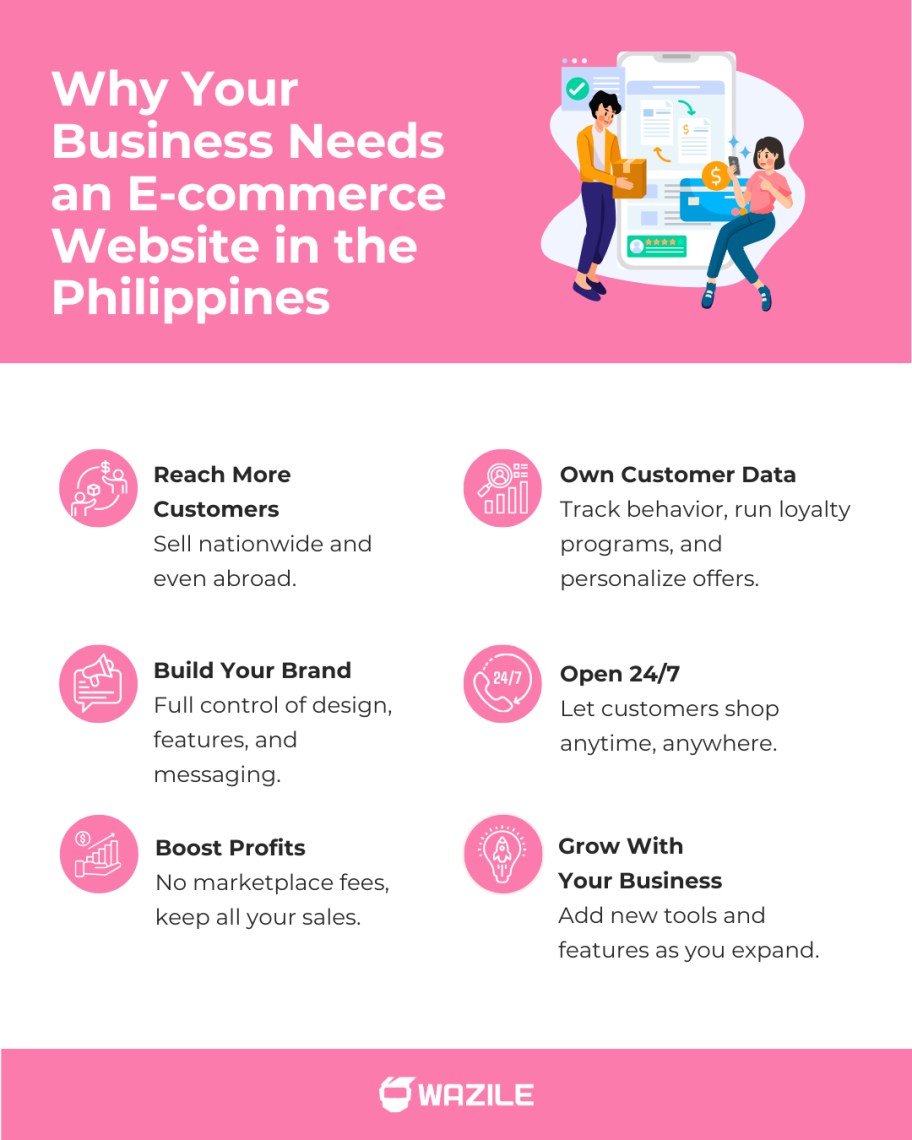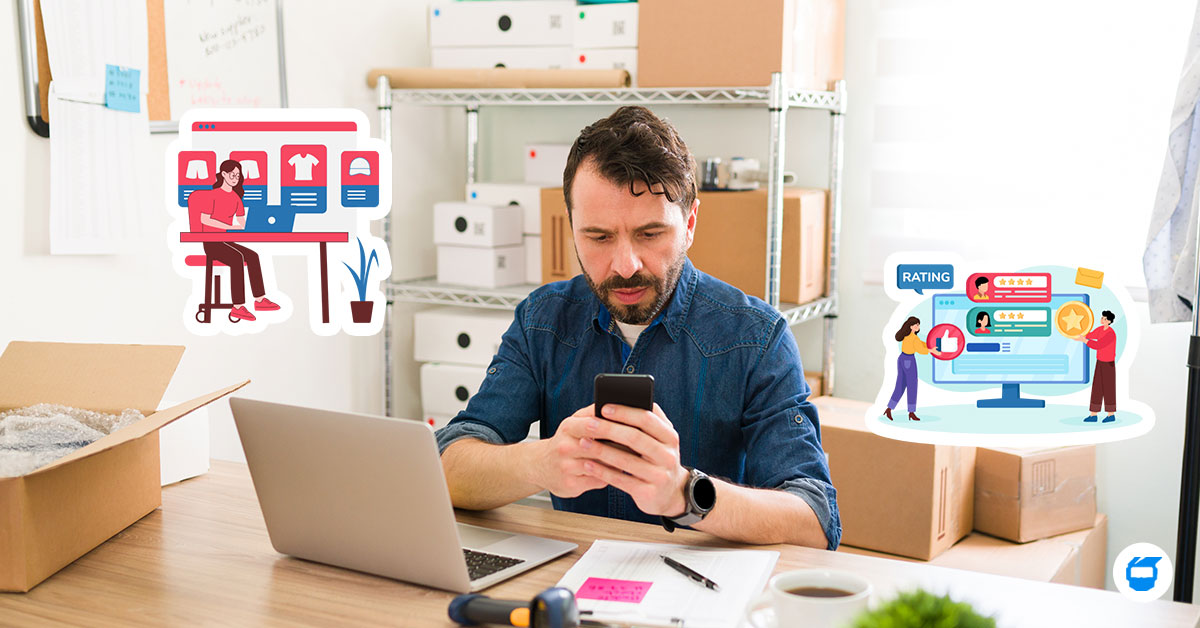The Philippines has quickly become one of Southeast Asia’s fastest-growing digital markets, and the second-fastest growing e-commerce market in the world. With more people shopping online than ever, businesses of all sizes are realizing the importance of having a strong online store. Whether you’re a startup or an established brand, investing in e-commerce development in the Philippines is no longer optional—it’s essential.

Table of Contents
- Why E-commerce Development Matters in the Philippines (Key Stats)
- Why Your Business Needs an E-commerce Website in the Philippines
- How to Start an E-commerce Business in the Philippines
- Understanding E-commerce Website Cost in the Philippines
- Best E-commerce Platforms in the Philippines
- Common Payment Methods for Online Shopping in the Philippines
- Marketplace vs. Your Own E-commerce Website in the Philippines
- E-commerce Development in the Philippines: Frequently Asked Questions (FAQs)
- Final Thoughts: Building Your Online Success
Why E-commerce Development Matters in the Philippines (Key Stats)

E-commerce in the Philippines isn’t just a passing trend—it’s reshaping how Filipinos shop and how businesses operate. With more people spending time online and choosing the convenience of digital purchases, the opportunities for growth are bigger than ever. To see just how massive this shift is, let’s look at some key stats that show why e-commerce is something businesses in the Philippines can’t afford to ignore:
- 97.5 million Filipinos are online in early 2025 — about 83.8% of the population (DataReportal).
- Nearly 46% of Filipinos shop online more than once per month (PCMI).
- By 2027, the Philippines e-commerce market is projected to hit US$40.5 billion (PCMI).
- Globally, the e-commerce market is expected to reach USD$5.5 trillion by 2027 (International Trade Administration).
These figures highlight one simple truth: having an e-commerce platform is no longer optional. With mobile-first shoppers, new digital payment methods, and increasing competition, businesses that don’t build an online presence risk being left behind in the digital race.
Why Your Business Needs an E-commerce Website in the Philippines

As we’ve mentioned above, it’s essential to have an ecommerce platform in this digital age—and with more and more Filipinos shopping online, relying only on physical stores or marketplaces limits your growth potential.
Related: What is an Ecommerce Website? A Guide to What You Need to Know
Here’s why your business needs its own e-commerce website:
- Reach More Customers – An e-commerce website lets you sell nationwide (and even abroad), beyond the limits of a single location.
- Build Your Brand Identity – Unlike selling on marketplaces, a custom e-commerce website in the Philippines gives you full control of your design, features, and messaging.
- Increase Profit Margins – Without marketplace fees or commissions, you get to keep 100% of your sales revenue.
- Own Your Customer Data – Gain insights into buyer behavior, run loyalty programs, and strengthen customer relationships.
- Stay Open 24/7 – Your store is always accessible, allowing customers to shop anytime.
- Scale With Your Growth – With the right e-commerce development strategy, you can easily add new features as your business expands.
Investing in professional e-commerce website development in the Philippines gives your business the competitive edge it needs to thrive in the country’s booming digital market.
How to Start an E-commerce Business in the Philippines
Getting into online selling doesn’t have to be overwhelming. Here’s a simple step-by-step guide for beginners:
1. Choose Your Niche and Products
Decide what you want to sell. It could be your own creations, curated items, or dropshipping products. Think about demand, competition, and what makes your store stand out.
2. Pick the Right Platform
Popular platforms include Shopify, WooCommerce, Magento, and even custom-built solutions. For small businesses, Shopify is user-friendly. For larger or more specific needs, a custom e-commerce website Philippines might be the smarter choice.
3. Work with an E-commerce Development Company
Partnering with a trusted e-commerce website development agency in the Philippines can save you from costly mistakes.They’ll help you with site design, payment gateways, security, and even scalability for future growth.
4. Set Up Secure Payments
Credit cards, debit cards, e-wallets like GCash and Maya, and even cash on delivery (COD) are widely used in the Philippines. Making sure your site supports multiple payment methods isn’t just about convenience—it’s about building trust and reducing cart abandonment. The more flexible your checkout process, the more confident customers will feel about completing their purchase.
5. Market Your Store
An online store won’t sell itself. Invest in SEO, social media ads, and email marketing. A strong digital presence ensures your store gets noticed.
Understanding E-commerce Website Cost in the Philippines
One of the most common questions entrepreneurs ask is: “How much does an online store cost?” The answer depends on your needs.
Factors Affecting the Cost
- Platform Choice – Shopify charges monthly fees, while WooCommerce is free but requires hosting.
- Design & Features – A simple site costs less, while a custom e-commerce website Philippines with advanced features (inventory management, loyalty programs, etc.) will cost more.
- Developer Expertise – Hiring an experienced e-commerce development company in the Philippines may cost more upfront, but it saves you from future headaches.
- Maintenance & Updates – Don’t forget ongoing costs like hosting, security, and software updates.
On average, the cost of an e-commerce website in the Philippines ranges from ₱30,000 to ₱200,000 depending on complexity. For startups, there are also packages offering affordable e-commerce website development in the Philippines that balance quality with budget-friendliness.
Best E-commerce Platforms in the Philippines
When it comes to e-commerce website development in the Philippines, choosing the right platform is one of the first big decisions you’ll make. Here are the most common options:
● Shopify
A fully hosted solution that’s great for beginners. It has monthly fees but comes with built-in hosting, templates, and payment integrations, making setup quick and easy. If you’re aiming for a more tailored approach, investing in custom Shopify website design and development allows your online store to stand out with unique branding, better functionality, and scalability as your business grows.
Related: What is Shopify? Pros, Cons, and How to Choose a Shopify Web Designer
● WordPress + WooCommerce
WordPress is a free Content Management System (CMS), and WooCommerce is its powerful e-commerce plugin. When combined, they give you full flexibility, ownership, and plenty of customization options. This setup is a popular choice for small to medium-sized businesses looking for affordable e-commerce website development in the Philippines. The trade-off? You’ll need separate hosting and at least some technical know-how—or the help of a developer—to get everything running smoothly.
● Magento (Adobe Commerce)
Magento, now branded as Adobe Commerce, is a powerful, enterprise-level e-commerce platform. It’s best suited for large businesses or enterprises that need advanced features, complex integrations, and high scalability. While it offers unmatched flexibility and customization, it also requires significant technical expertise and higher development costs compared to beginner-friendly platforms.
● Custom E-commerce Website Philippines
A custom e-commerce website is built from scratch and tailored exactly to your business needs. Though it may require a higher investment upfront, it provides the highest level of control, unique branding, and limitless scalability. This option is perfect for businesses that want a future-proof online store designed to grow with them.
Common Payment Methods for Online Shopping in the Philippines
One of the biggest factors that influence online shopping in the Philippines is payment convenience. Unlike other countries where credit cards dominate, Filipino shoppers use a variety of payment methods:
- Cash on Delivery (COD) – Still the most popular option since many Filipinos prefer to pay only once they receive their orders.
- E-wallets – GCash, Maya, and ShopeePay have rapidly grown in adoption, making cashless transactions easy and secure.
- Bank Transfers & Debit/Credit Cards – Widely used for higher-value purchases or for customers who shop regularly online.
- Over-the-Counter Payments – Some e-commerce platforms allow payments through convenience stores like 7-Eleven and Cebuana Lhuillier, which cater to unbanked customers.
TIP: For businesses exploring e-commerce website development in the Philippines, offering multiple payment methods is key to building trust and ensuring smooth transactions.
Marketplace vs. Your Own E-commerce Website in the Philippines
A lot of business owners wonder: “Why not just sell on Shopee, Lazada, or TikTok Shop?” Marketplaces are a great way to gain visibility fast, but relying on them alone has limitations. Here’s a breakdown:
Marketplaces (Shopee, Lazada, TikTok Shop)
Advantages:
- Built-in traffic and access to a large customer base
- Easy to set up and start selling right away
Disadvantages:
- Extremely high competition from other sellers
- Seller fees cut into your profit margins
- Limited opportunities for branding and customization
Your Own E-commerce Website
Advantages:
- Full control over design, branding, and customer experience
- Keep 100% of your profits without marketplace fees
- Build long-term loyalty by owning your customer database
Disadvantages:
- Requires an upfront investment
- You need to drive your own traffic through marketing and SEO
E-commerce Development in the Philippines: Frequently Asked Questions (FAQs)
1. How much does e-commerce website development cost in the Philippines?
The e-commerce website cost in the Philippines varies depending on the platform, design, and features. Simple sites can start around ₱30,000, while more advanced custom e-commerce websites in the Philippines can go over ₱200,000.
2. Is affordable e-commerce website development in the Philippines possible?
Yes! Many agencies and freelancers offer packages for affordable e-commerce website development in the Philippines, which are perfect for startups and small businesses that want to go online without overspending.
3. What is the best platform to start an e-commerce business in the Philippines?
It depends on your needs. Shopify is great for beginners, WooCommerce is flexible for WordPress users, while a custom e-commerce website Philippines works best for businesses with specific requirements.
4. How do I start an e-commerce business in the Philippines?
Begin by choosing your niche, selecting the right platform, hiring experts in e-commerce website development Philippines, and setting up secure payment options. Don’t forget to market your store online to attract customers.
5. Why should I invest in e-commerce development in the Philippines?
The benefits of e-commerce development in the Philippines include wider reach, lower costs, 24/7 accessibility, and better insights into customer behavior—making it a smart investment for businesses of all sizes.
Final Thoughts: Building Your Online Success
E-commerce in the Philippines is booming, and businesses that take action now will gain a strong advantage in the market. Starting with e-commerce website development or investing in a tailor-made online store can transform how you operate. If you’ve been asking how to start an e-commerce business in the Philippines, this guide is your first step.
Ready to take your business online? Whether you need affordable e-commerce website development in the Philippines or a custom-built solution, our team can help you build an online store that sells. Contact us today!


